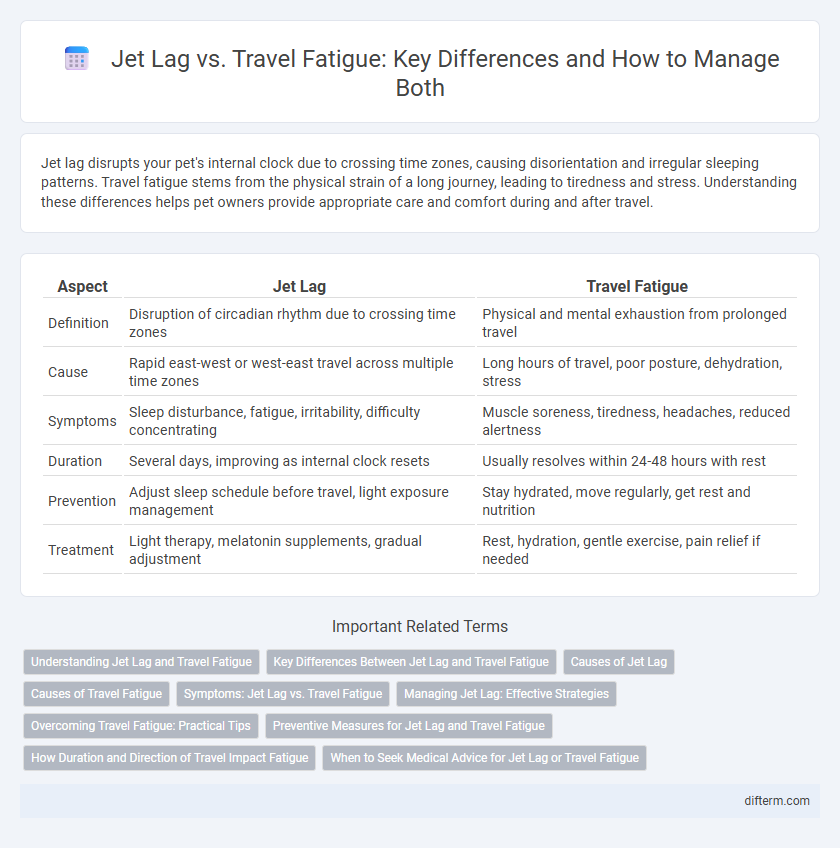Jet lag disrupts your pet's internal clock due to crossing time zones, causing disorientation and irregular sleeping patterns. Travel fatigue stems from the physical strain of a long journey, leading to tiredness and stress. Understanding these differences helps pet owners provide appropriate care and comfort during and after travel.
Table of Comparison
| Aspect | Jet Lag | Travel Fatigue |
|---|---|---|
| Definition | Disruption of circadian rhythm due to crossing time zones | Physical and mental exhaustion from prolonged travel |
| Cause | Rapid east-west or west-east travel across multiple time zones | Long hours of travel, poor posture, dehydration, stress |
| Symptoms | Sleep disturbance, fatigue, irritability, difficulty concentrating | Muscle soreness, tiredness, headaches, reduced alertness |
| Duration | Several days, improving as internal clock resets | Usually resolves within 24-48 hours with rest |
| Prevention | Adjust sleep schedule before travel, light exposure management | Stay hydrated, move regularly, get rest and nutrition |
| Treatment | Light therapy, melatonin supplements, gradual adjustment | Rest, hydration, gentle exercise, pain relief if needed |
Understanding Jet Lag and Travel Fatigue
Jet lag results from the disruption of the body's circadian rhythm due to rapid long-distance travel across multiple time zones, causing sleep disturbances, fatigue, and impaired cognitive function. Travel fatigue arises from extended periods of physical and mental exertion during travel, including prolonged sitting, dehydration, and stress, leading to exhaustion even without crossing time zones. Recognizing the differences between jet lag and travel fatigue helps travelers implement targeted strategies for recovery and maintain optimal health and performance.
Key Differences Between Jet Lag and Travel Fatigue
Jet lag occurs due to disruption of the body's internal clock when crossing multiple time zones, leading to symptoms like insomnia, headaches, and cognitive impairment. Travel fatigue results from extended periods of physical exertion and inactivity during travel, causing muscle stiffness, dehydration, and general tiredness without significant circadian rhythm disturbance. Understanding these differences helps travelers implement targeted recovery strategies such as light exposure for jet lag and hydration plus movement to alleviate travel fatigue.
Causes of Jet Lag
Jet lag causes stem primarily from rapid travel across multiple time zones, disrupting the body's internal circadian rhythm. Exposure to altered light-dark cycles interferes with melatonin production, leading to sleep disturbances and cognitive impairment. Factors such as flight duration, direction of travel, and individual sensitivity to time shifts significantly influence the severity of jet lag symptoms.
Causes of Travel Fatigue
Travel fatigue primarily results from prolonged physical and mental strain during journeys, including extended periods of sitting, heavy luggage carrying, and airport navigation stress. Unlike jet lag, which stems from disrupted circadian rhythms due to crossing time zones, travel fatigue arises from cumulative exhaustion linked to travel-related activities and environmental factors. Dehydration, irregular meals, and sleep deprivation during transit also significantly contribute to the onset of travel fatigue symptoms.
Symptoms: Jet Lag vs. Travel Fatigue
Jet lag symptoms include sleep disturbances, daytime fatigue, difficulty concentrating, and digestive problems due to disrupted circadian rhythms after crossing multiple time zones. Travel fatigue primarily manifests as muscle soreness, dehydration, headaches, and general tiredness caused by prolonged physical exertion and limited rest during travel. Recognizing these distinct symptoms aids in implementing targeted recovery strategies for effective post-travel adjustment.
Managing Jet Lag: Effective Strategies
Managing jet lag effectively involves regulating exposure to natural light to reset the body's internal clock and maintaining hydration to alleviate symptoms of fatigue. Strategic planning of sleep schedules before travel and using short naps upon arrival can facilitate quicker adjustment to new time zones. Incorporating physical activity and avoiding caffeine or alcohol close to bedtime support the body's adaptation and reduce the severity of jet lag during international travel.
Overcoming Travel Fatigue: Practical Tips
Overcoming travel fatigue involves prioritizing hydration, balanced meals, and regular physical activity to restore energy levels after long journeys. Adjusting sleep patterns gradually before travel and maximizing natural light exposure upon arrival can reset the body's internal clock. Incorporating short naps and avoiding caffeine or heavy meals near bedtime also helps minimize symptoms of travel-related exhaustion.
Preventive Measures for Jet Lag and Travel Fatigue
To prevent jet lag, travelers should gradually adjust their sleep schedule to the destination's time zone before departure and stay hydrated during the flight. Combat travel fatigue by incorporating short breaks, light exercise, and balanced meals throughout the journey to maintain energy levels. Exposure to natural daylight upon arrival helps reset the body's internal clock, minimizing disruptions caused by time zone changes.
How Duration and Direction of Travel Impact Fatigue
Travel fatigue and jet lag are influenced by the duration and direction of travel, with long-haul flights across multiple time zones significantly increasing the severity of jet lag symptoms. West-to-east travel disrupts the body's circadian rhythm more than east-to-west flights, causing greater difficulty in adjusting sleep patterns and heightening fatigue levels. Shorter trips or those within the same time zone primarily result in travel fatigue, characterized by physical tiredness and muscle stiffness, which tends to resolve quicker than jet lag.
When to Seek Medical Advice for Jet Lag or Travel Fatigue
Seek medical advice for jet lag or travel fatigue if symptoms persist beyond a week, significantly disrupt daily activities, or include severe headaches, dizziness, or difficulty breathing. Individuals with pre-existing health conditions, such as cardiovascular or respiratory issues, should consult a healthcare professional promptly after experiencing intense travel-related fatigue. Persistent insomnia or mental health disturbances linked to travel should also prompt timely medical evaluation to rule out underlying conditions.
Jet lag vs Travel fatigue Infographic

 difterm.com
difterm.com